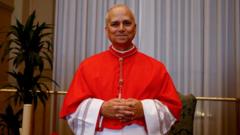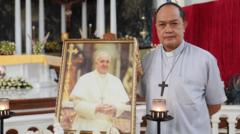In the wake of Pope Francis' death last month, the Vatican conclave assembled on Thursday morning, signaling a critical moment for the Catholic Church as no consensus emerged from the morning vote. The black smoke from the Sistine Chapel indicated that once again, the cardinals failed to agree on a successor.
Black Smoke Signals Continued Cardinal Challenges in Vatican Conclave

Black Smoke Signals Continued Cardinal Challenges in Vatican Conclave
As voting resumes today, anticipation grows for a papal decision amid mixed feelings and unexpected divisions among cardinals.
First, the crowd in St. Peter’s Square reacted with disappointment as the first wave of voting concluded around noon, with spectators and faithful listeners fidgeting with eagerness. The conclave, now on its second day, will hold further secret ballots this afternoon, with all eyes pointed toward the chimney above the chapel. The cardinals, totaling 133, now must deliberate their choices in a newly complex environment, one shaped by Francis’ contentious legacy and a mix of traditionalist and progressive factions within the Church.
Ensuing the emotional stakes of the conclave, onlookers gathered, hoping for white smoke to signal the emergence of a newly elected pope. The scenes of excitement were contrasted with solemnity, as many recognized the gravity of the situation, given that the last two conclaves concluded within two days.
While cardinal electors adhere to the principle of conducting secret ballots, various factions within the assembly complicate the selection process, as there is speculation regarding the potential impact of their diverging priorities on the future direction of the Church. The implications of unity and inclusion touted by certain cardinals ring loudly in this time of transition. Cardinal Dolan from New York observed that the gathering is particularly complex due to the diverse backgrounds of many electors, largely selected by Francis himself.
With historical context in mind, the conclave’s process this time could last longer than recent selections, creating an atmosphere ripe with tension as factions push for their respective visions of papal leadership — either to continue Francis’ inclusive approach or revert to more conservative values.
As the day unfolds, Vatican City holds its breath, awaiting the next sign from the Sistine Chapel, while the public and contemplative faithful remain intently focused on the developing narratives emerging from the historic conclave.
Ensuing the emotional stakes of the conclave, onlookers gathered, hoping for white smoke to signal the emergence of a newly elected pope. The scenes of excitement were contrasted with solemnity, as many recognized the gravity of the situation, given that the last two conclaves concluded within two days.
While cardinal electors adhere to the principle of conducting secret ballots, various factions within the assembly complicate the selection process, as there is speculation regarding the potential impact of their diverging priorities on the future direction of the Church. The implications of unity and inclusion touted by certain cardinals ring loudly in this time of transition. Cardinal Dolan from New York observed that the gathering is particularly complex due to the diverse backgrounds of many electors, largely selected by Francis himself.
With historical context in mind, the conclave’s process this time could last longer than recent selections, creating an atmosphere ripe with tension as factions push for their respective visions of papal leadership — either to continue Francis’ inclusive approach or revert to more conservative values.
As the day unfolds, Vatican City holds its breath, awaiting the next sign from the Sistine Chapel, while the public and contemplative faithful remain intently focused on the developing narratives emerging from the historic conclave.






















